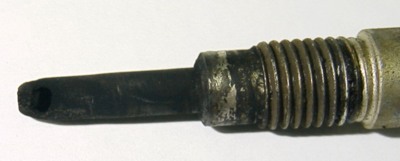Awhile back, I decided to address a cold start condition. The symptom was the engine would start up ok on 3 cylinders with one cylinder just lazy / late in firing off ... say 5-10 seconds later. Not as apparent when the overnight temperatures were mild but this was Fall with cooler nights becoming more prevalent.
Tested while still installed, all glow plugs had comparable resistance. Hmmm. Ok, I decided to remove them from the engine to bench test and observe their operation. The #3 glow was a little difficult to withdraw from the head. It unscrewed but could not be withdrawn without using pliers. I finally got it out. No wonder ... the end had blown off! Interesting too is that #3 glow was the only one that still had some factory green paint on it while the others have been replaced but long long ago.

The adjacent glow plug is one of the other three that came out normally.
The interesting thing I found is that the non-operating glow still had specification resistance which I can only attribute to conductive carbon being packed up inside the glow plug housing.
Bench testing revealed two ways to verify actual performance. Using a power source like a car battery with an ammeter or (as I did) a 20 amp battery charger with an ammeter, you can ...
1) visualize actual glow performance
2) observe the amperage draw change as the glow plug achieves maximum temperature.
So if you don't want to pull each plug, then test them individually (remove the connector harnass) and use a power source with an ammeter.
Testing the glows individually, typical initial amperage draw in the first 2 seconds is 18 amps ... which falls to 5-7 amps in the span of 12-15 seconds.
While researching an answer to another thread, I put my voltmeter to the #1 glow plug terminal and turn ON the ignition.
Voltage jumped to 8.8v ... and over the next 10 seconds rose to 10v. The voltage rise reflects increasing resistance as the glows reach maximum temperature.
Voltage drop across the single blade/spade connector for the glows while in operation was 0.06v .
Upon completion of one glow cycle, the white/red wire from the duty relay to the glows connector exhibits a little warmth. So ... there must be some resistance along that wire when carrying (briefly) 60-70 amps ... tapering quickly to 25 amps (thereabouts) for the remaining preglow time. Of course the glows themselves further the voltage loss because of their amperage flow.]
Here are the values I just measured during the 30 seconds the glows are ON:
Key OFF, volts across battery terms = 12.2v
Key ON, voltage at #1 glow starts 8.8v and stabilizes at 10v
Key ON, #1 glow voltage stabilized, volts across battery terms = 11.8
(Next morning ... more diagnosing the missing 1.8 volts)
Key OFF, volts across battery terms = 12.2
Key ON, duty relay ON, Glow plugs connected, measurement from battery +post to duty relay power terminal = 0.6v
Key ON, duty relay ON, Glow plugs connected, measurement across heavy current terminals = 0.05v
Key ON, volts across White/red wire from duty relay output terminal to glow plug bus connector = 0.6v .
Key ON, volts across glow plug wire from glow plug bus connector to #1 glow plug = 0.2
Neither heavy current connectors showed significant voltage loss.
My battery is a group 27F (big for the tray) 725 CCA@0*.
Looks like we've found at least 1.4volts. The best bang for the buck is doing a parallel connection (Al mentions LD28 solution ) from the glow plug bus connector to the duty relay. This IS the same wire that warms after two GP cyclings.
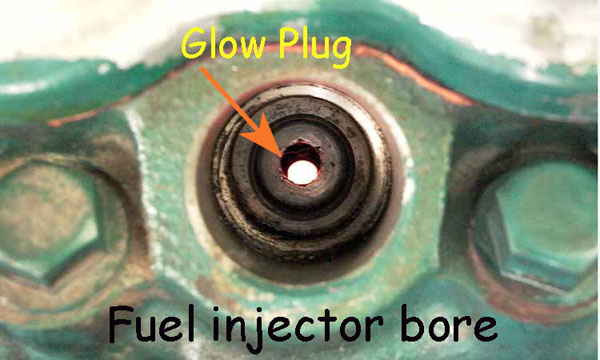
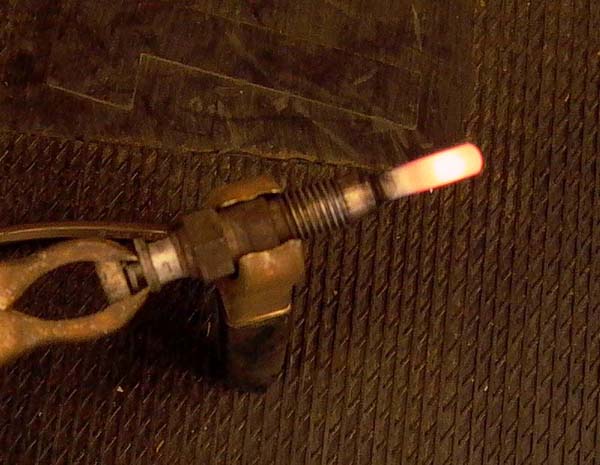
The SD22 has a single stage AutoAfterGlow system managing 12v current to the glow plugs, identified as the "Type 1" system.
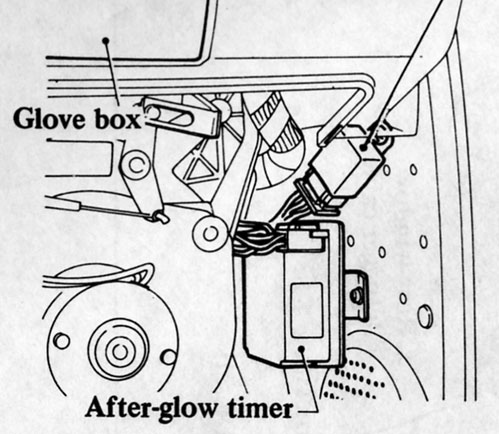
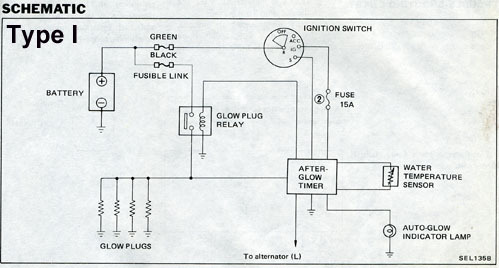
(The SD25 has a two step voltage system (AutoAfter Glow Type-II) which necessitates a different spec glow plug having a much shorter warm-up time, two relays, a dropping resistor, and a different AutoAfterGlow timer having two stages and a shorter ON time period)
For 12volt glow plugs fitting the SD22 ("Quick-Start" type Y-112TS)
(NGK as of Oct 7, 06) NGK chart for SD22
Pick-Up 720 Oct 1979 - Jan 1982 4cyl 2.2-liter SD22 Y-112TS

(900ºC = 1650ºF)
"Quick-start type" glow plugs are one type of sheathed glow plug that have a heating curve whose resistance changes with the temperature. The resistance is initially low so that plenty of current flows through the heating curve. The temperature increases faster than in standard plugs – and as a result the preheating time reduces.
"Quick-start type" are used in the SD22 type I system. These glows take about 10-15 seconds to reach peak temperature.
SAGE ADVICE from Al ...
If you are removing a glow plug, and it turns with reasonable torque for a turn or two, but then becomes hard to turn, STOP. Remove that cylinder's injector, bring that cylinder's piston to TDC, then remove the GP.
Chances are that the tip of the GP will break off and fall into the prechamber (and then the GP will turn easily again). If the piston is at TDC, the broken-off tip can't fall out of the prechamber and into the main cylinder.
With the injector and GP removed, you can now use compressed air or a magnet (in the GP's hole) to remove the tip out the injector hole, thus avoiding the need to remove the whole damned head.
Don't think you can just start the engine and "blow it out the tailpipe" because severe engine damage can and has been done trying to use that method.
